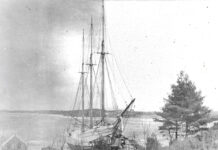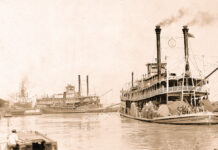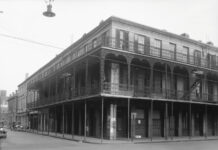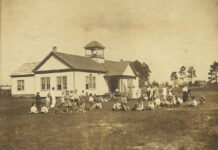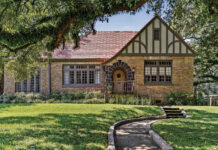
In 2018, Cheryl Bradley, retired reference librarian, and I started organizing the Fairhope Public Library archives and vertical files for digitization. Looking back, I cannot believe how much history passed through our hands during that summer. What began in a room in Marie Howland’s home, named The Pines, on the southeast corner of Magnolia Avenue and Summit Street, became Fairhope’s first library. It opened April 18, 1900 and celebrates its 125th anniversary this month.
In the library’s first year, 1901, thanks to excellent record-keeping, we know the library circulated 450 books, not including periodicals. They ranged from “The Adventures of Huckleberry Finn” to books on vegetarianism and spiritualism, specifically Theosophy. There is, of course, one item, a book, that stands out. It’s the 1902 Fairhope Free Public Library Catalog.
Marie Howland arrived in Fairhope in 1899 having led a full life, including stops in four experimental communities. She and her husband Edward Howland collected books, which started when Edward graduated from Harvard and funded America’s first Bohemian newspaper, The Saturday Press, in Greenwich Village, New York City. He and Marie traveled through Europe during the Civil War purchasing books for a book dealer and amassing their own collection. They continued expanding their library upon their return to the United States where they settled at Casa Tonti in Hammonton, New Jersey. In 1888, the couple brought the library to the socialist community in Topolobampo, Mexico, where Edward died in 1890. It was this remaining collection, “a remnant of a remnant,” according to Marie, that, 10 years later, served as the basis for the Fairhope collection. In her preface to the catalog, dated February 24, 1902, she writes, “It will be a great convenience to the patrons of the library, as well as an indispensable aid to the librarian.” She numbers the collection at 1,662, with 898 as the nucleus from the Howland collection, and 764 from all other sources, including locals bringing books by the “wheelbarrow.” In her own handwriting, on New Year’s Day in 2003, Howland tallies the collection at 2,045 books. She organized the collection by the size of the books.
I revisited the catalog — a scrapbook really — on Valentine’ Day and I fell in love with it all over again. The earthy scented, brown-toned pages are filled throughout with Howland’s script. There are black and red slash marks, margin notes, cross references between title and author. Much of the catalog is copied and pasted parts from the Topolobampo collection. In its day, it was a living document constantly being revised. The catalog listed five centuries of books. The catalog is now available on the Fairhope Public Library Digital Collections and through the Fairhope Single Tax Online Archives.
The remaining 250 volumes of the Howland Collection, including the catalog created for Topolobampo, are stored in the Fairhope Museum of History archive. A select few are shelved at the Fairhope Public Library as part of its Legacy Collection, which includes the first edition of Marie Howland’s 1874 novel “Papa’s Own Girl.”
The Fairhope Public Library, like much of early Fairhope, was a Fairhope Single Tax Corporation (FSTC) institution. The corporation paid Howland a small sum to operate the library, which was housed in Marie Howland’s parlor and eventually grew so large it overflowed onto her front porch. The colony decided to build a library. It was completed in 1908, the year Fairhope was incorporated. It was, so the story goes, the first library built in Alabama specifically for a public library. Yes, there were older public libraries in Alabama like Huntsville, but they were in repurposed buildings. Joseph Fels, of Fels Naptha Soap fame, and a Fairhope supporter, was the philanthropist who pitched in $1,000 for the one-room library. It still stands, with the north and east wall still visible. There were eight cases of books in that one room. The cases were identified as A. B. C. D. E. E¹. E². E³. Two of those cases are in the fiction section today. Four additions were built, and the library also housed a small museum of locally donated items, including several stuffed creatures. The library was an FSTC entity until 1964 when its operation was turned over to the City of Fairhope.
In 1983, six months before the library was to move, Betty Suddeth was hired. She was immediately tasked with the challenge of moving 83 years of Fairhope’s literary culture. When Delchamps Supermarket left the Del-Fair Shopping Center, the city renovated it for the civic center and offices. The library moved to the western end of the city municipal complex where the University of South Alabama nursing program is today.
“There was a grey ceramic cat on the hearth in the library on Section Street.” The fireplace was in the Marie Howland Reading Room. Suddeth remembered, “I called him Dewey D. for obvious reasons.” It may not be so obvious these days. Melville Dewey, a librarian and educator, created the Dewey Decimal System to help patrons find books in 1876. Most public libraries still use this catalog system.
Betty is the queen of the double move. When I moved to Fairhope in 2005 the new library was under construction, and I covered it as a reporter for the Fairhope Courier. At 35,000 square feet, library lovers called it the cultural center of town. For the naysayers, it was “the Taj Mahal.” It opened in February 2007.
“When we moved to the new library I put the cat on my bookshelf in my office.” In a hushed voice Suddeth added, “I don’t know if I should be telling this, but the statute of limitations is probably past.” She laughs at the thought, “The library police aren’t coming after me.”
“When I retired in 2007, I took Dewey D. home with me!” He’s on her hearth now, a reminder of the patrons who walked by him in the Marie Howland Reading Room. About the Fairhope Avenue library, Suddeth is so humble, “I’m so proud of our community for valuing our library.” So proud, she’s still there! We talked while Suddeth volunteered at the Friends of the Fairhope Library bookstore.
Susan Diemert started shortly after Suddeth, and 41 years later, she’s the cataloger with fond memories of those early years. “When I worked in Circulation in the late ‘80’s, I used a card sorter to sort the cards from the previous day’s check outs and recorded the numbers for each category in a logbook. It was my favorite job of the day because I got to see what people were reading, how many books were checking out each day, plus it was fun sorting the book cards using this tool made specifically for libraries.”
At the time, the library used a “technology” called a Gaylord machine. Patrons no longer signed their names on the book cards, instead they were stamped with a due date and card number from the metal plate attached to their cards. “For many years we had a list of patron numbers near the machine to “catch” patrons with overdue books or large fines,” Diemert recalled.
Trista Lackey, Reference manager and staff member since 2012, points out the stunning stained-glass window, created through the collaboration of two local artists — Dean Mosher who designed it and another, Sandra Ward, who brought it to life.” The window portrays an adult owl reading a book to a young owl, both surrounded by vibrant flowers, with Mobile Bay serving as a picturesque backdrop. Glancing up at the glass, Trista said, “The owl, a timeless symbol of wisdom and knowledge, adds a meaningful touch to this beautiful artwork. It reminds me of our library’s commitment to being a Fairhope community hub for people of all ages.”
The stained-glass window is a case of history repeating itself. A stained-glass window memorial was installed on the southwest corner of the window of 10 North Summit Street shortly after Howland died in 1921. For Fairhope’s Centennial in 1994, Robbie Wolff made a custom cabinet for the stained-glass window. For as long as I can remember, it’s been located just outside the elevator on the second floor.
Library Director Robert Gourlay added, “There is so much beauty in the design and architecture of the building that always leaves people in awe.” By the time you read this, the teen area will be open, completing the second-floor expansion started under former director Tamara Dean. Whenever I walk in, I’m impressed by the collections, the art, the computers, and staff, but as a patron, I continue to be in awe of Marie Howland. Through her enlightened personality, the gift of the Howland Collection, and her dedication to community, the legacy of the Fairhope Public Library lives on.
Fairhope Public Library // 501 Fairhope Avenue. fairhopelibrary.org

